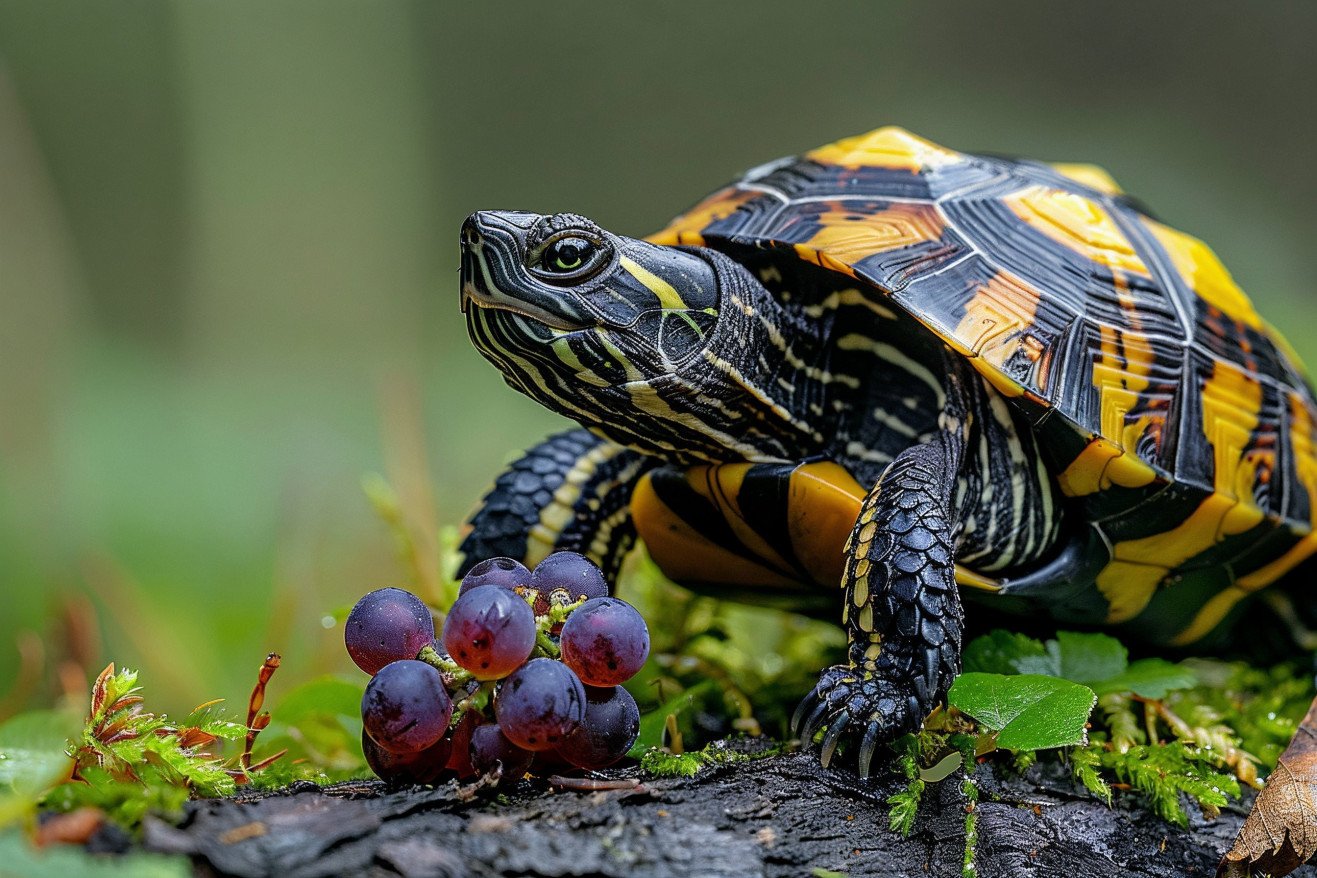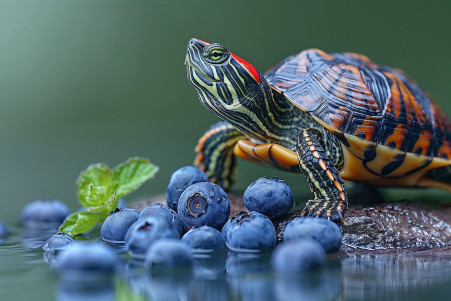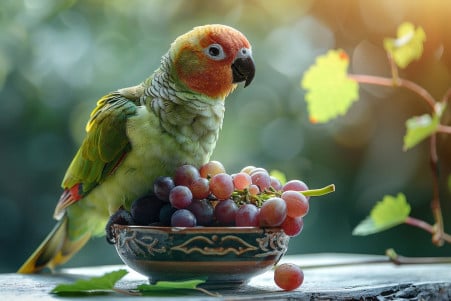Can Turtles Have Grapes? A Nutritionist Weighs in on the Facts and Safety
6 April 2024 • Updated 5 April 2024

If you’ve ever wondered whether or not your pet turtle can enjoy a sweet, juicy grape, there are a few things you should know about the potential risks and benefits of feeding this fruit to your shelled companion. Grapes are not part of a turtle’s natural diet and can lead to digestive problems if they are consumed in large quantities. That said, when fed occasionally and in small amounts, grapes can offer turtles some vitamins, antioxidants, and hydration. That said, it’s important to use caution and not overdo it if you decide to feed your turtle grapes.
To help you better understand the nuances of a turtle’s nutritional needs and whether or not grapes are a good fit for them, we referenced veterinary nutrition experts and turtle experts for their thoughts. This article covers everything from the unique digestive systems of different types of turtles to the potential risks and limited benefits of feeding grapes to turtles. By the time you’re done reading, you’ll know exactly how to feed your turtle grapes safely based on their species and life stage.
Can turtles eat grapes?
Types of Turtles and Their Dietary Needs: How Much Grapes to Feed
Grapes should not be given to turtles in the same amount across the board. Instead, the specific dietary needs of different types of turtles should be taken into account. For example, according to Turtle OMG, grapes can account for 14-16% of the diet of land turtles like the ornate box turtle, while aquatic turtles like the red-eared slider should only eat grapes as a treat because they are so high in sugar.
For box turtles, which are omnivorous and found in North America, PetAssure says that fruits like grapes, blackberries, and apples should make up no more than 9-10% of their diet. In contrast, the diet of aquatic turtles should be made up of vegetables, feeder fish, and a small amount of fruit like grapes and melons.
In general, grapes should be fed to all turtles in moderation. While land turtles can eat a higher percentage of fruit, VCA Animal Hospitals says that fruit should still be fed less often than vegetables because it is higher in sugar and lower in nutrients. Feeding any turtle too many grapes can lead to obesity, gastrointestinal problems, and malnutrition.
In the end, it's best to work with a reptile vet to create a diet plan for your pet turtle that includes the right amount of grapes based on their species. A vet can help you make sure that grapes are added to your turtle's diet in a way that is safe and healthy based on their age, species, and health.
Grapes for Turtles: Pros and Cons
While grapes can offer some health benefits for turtles, they should be used sparingly as part of a well-rounded diet. According to Turtle OMG, grapes are more than 80% water, so they can help keep turtles hydrated. They also contain several vitamins, including vitamin A, which is important for turtles’ eye health, immune systems, and overall development.
That said, the sugar in grapes can be a problem if they’re consumed in large amounts. Hepper notes that feeding turtles too many sugary fruits like grapes can lead to obesity and other health problems. What’s more, the calcium-phosphorus ratio in grapes may not be right for turtles’ bone and shell development, according to Turtle OMG.
To make sure turtles get the nutrients they need, VCA Animal Hospitals suggests that grapes and other fruits should only make up a small part of their diet, with most of their food coming from nutrient-dense vegetables. If grapes are fed in moderation as part of a balanced diet, turtles can eat them as an occasional source of hydration and vitamins without any negative effects.
How to Feed Grapes to Your Turtle
Feeding grapes to your turtle will require some planning to make sure that your pet gets the nutrients it needs. According to WebMD, turtles need a well-rounded diet that includes protein, vegetables, and a small amount of fruit. While grapes can help with hydration and provide some vitamins, they should be a small part of the overall diet.
AllCreatures.ca says that fruit, including grapes, should make up about 25% of a box turtle's diet. Meanwhile, for aquatic turtles, grapes and other fruit should be fed in smaller amounts as an occasional treat, with the majority of the diet consisting of leafy greens and protein. Hepper warns that high-sugar fruits like strawberries and grapes can cause digestive problems and obesity if they are overfed.
To make sure that your turtle gets a balanced diet, it's important to include a variety of vegetables, such as the collard, dandelion, and mustard greens that are recommended by WebMD. When you introduce new foods like grapes, it's best to do it slowly so that your turtle's digestive system can adjust and you can avoid any negative effects.
How Often Should You Feed Your Turtle?
Feeding frequency and portion size are important factors in keeping pet turtles healthy. According to Pets on Mom.com, juvenile turtles need the most frequent feedings, which means they need vitamin and calcium supplements three times a week and daily meals. On the other hand, adult pet turtles can be fed every other day or even every two to three days.
In terms of portion size, King British says that a portion of dried turtle food should be about the size of the turtle's head, while a portion of live food or vegetables should be a little larger. Overfeeding can lead to obesity and other health problems, so it's important to keep an eye on your turtle's eating habits and adjust the portion size if you notice that they're not eating everything you give them.
As WikiHow suggests, removing any food that hasn't been eaten after 20 minutes, unless it's live prey, can help prevent overfeeding and keep the habitat clean. By keeping these tips in mind and adjusting the feeding schedule and portion sizes based on your turtle's age and species, you can make sure your pet gets the nutrition they need to be healthy.
How to Change a Turtle's Diet: The Best Way to Do It
Changing a turtle's diet, including adding grapes, should be done slowly and carefully. According to B & H's Turtle Site, using feeding devices like tweezers or tongs can help turtles go from live food to non-living/pelleted food. The site recommends starting with live mealworms or crickets and then moving on to freeze-dried versions to help the turtle get used to the new food.
WikiHow also says that you should try to make non-living food move like live food. Turtles are attracted to movement, so moving the food around a little bit can help them become interested in it. You can also try to mix new foods like grapes with foods your turtle already likes to help them get used to the new flavor.
It's also important to make sure that your turtle's habitat is set up properly during the transition. If the temperature is too low or the UVA and UVB light isn't right, turtles are less likely to eat, according to WikiHow. It's also important to be patient and keep trying, as it can take time for turtles to get used to new foods.
If these methods are used to slowly introduce grapes and other new foods, pet owners can successfully change their turtles' diets to be more diverse and healthy. This sets the stage for grapes and other new foods to be safely and effectively added to the diet as an occasional treat.
Conclusion: Grapes Should Be Eaten in Moderation and as Part of a Balanced Diet
Feeding grapes to turtles requires a balanced and thoughtful approach. While grapes can offer turtles some benefits, such as hydration and vitamins, they should be fed in moderation and as part of a balanced diet. This means that they should be fed as an occasional treat rather than as a regular part of a turtle's diet.
It's also important to take into account the dietary needs of different turtle species. For example, grapes can make up about 9-10% of a terrestrial turtle's diet, such as a box turtle, while the high sugar content of grapes means that aquatic turtles, such as red-eared sliders, should eat them only occasionally. Overfeeding grapes can lead to health problems, such as obesity and issues with nutrient absorption.
Working with a veterinarian or another reptile expert can help you create a balanced and individualized diet plan for your turtle. This will ensure that you're feeding your turtle grapes and other foods in the right portion sizes and at the right frequency and that you're offering them a variety of safe foods, including grapes, in a way that will help them get the most nutritional benefit.
By focusing on a varied and nutrient-rich diet, pet owners can help ensure that their turtles get the nutrition they need to stay healthy and thrive.


